The Value of Onsite Research by Nancy Blanton #Research #amwriting #HistoricalFiction @nancy_blanton
The Value of Onsite ResearchBy Nancy Blanton
 Blarney Castle.
Blarney Castle.To me and probably many other authors, the double-edged sword of historical writing is pleasure and responsibility. On the pleasure side is travel. I must travel. I enjoy travel. I feel fortunate when I do. I learn so much. On the other side, responsibility requires that I travel for information, striving for accuracy in my writing, which is very hard work indeed, takes time, and can sometimes be costly.
When I tell new acquaintances I write historical fiction set in 17thcentury Ireland, often I get a wink and a smile: “So you get to travel,” they say, as if it’s all a big ruse, I can expense it on my taxes and basically travel for free.
If only. I do have to pay for it all out of pocket, and it is my work. There is really no substitute for firsthand experience with the locations, the sounds, voices and accents, the opportunity to walk in the footsteps of historical figures, and to see what they might have seen. I record it and share it.
Those of us who are fans of best-selling author Diana Gabaldon know the story, that she had never visited to Scotland before writing her famed Outlander series. She’s a gifted writer whose agent signed her on the basis of scenes alone, not even entire stories. Upon signing a three-book publishing contract she and her husband did indeed make the trip. She saw the big monolith and said yes, this is just as I imagined it.
 Diana Gabaldon (2010) author of Outlander — Wikipedia.
Diana Gabaldon (2010) author of Outlander — Wikipedia.Being there not only allowed her to confirm her vision and what her research had provided, but also likely enriched her work with sensations: the dampness of the air, the scent of the ground, the sounds of the trees, the calls of the birds, and perhaps even the taste of the Rhenish wine. It’s the five senses that make a location real to readers and bring scenes to life.
In addition, she gained the respect and adoration of the Scottish people. There’s an important human element involved in visiting a place one is going to write about in depth, of its geography, its history and its language and customs. Gabaldon spent weeks exploring Scotland. Now there are entire businesses developed around the Outlander theme and contributing to Scotland’s economy.
I have traveled to Ireland six times to see it, feel it, gather detail and hear what people have to say. I’ve had Irish readers tell me they’ve learned about their own history from reading my books. And I can hardly wait for the next time I go there, because I’ll never learn enough.
I last visited Ireland in April 2018, with an itinerary of places I wanted to see, so full I had to cross some of them off. My poor sister and traveling companion had never seen Ireland before, but eschewed the more common tourist sites to accompany me on this research trip. From Dublin airport, and with the invaluable help of my friends Eddie and Teresa of County Cork, we started at Malahide, then Drogheda, Dublin, Naas, Wicklow and Tinahely, then Waterford and Carrick-on-Suir. From there we headed west to Bandon and Skibbereen. We saw beautiful Kinsale and Blarney, then Adare, Clifton, Portumna, and Birr.
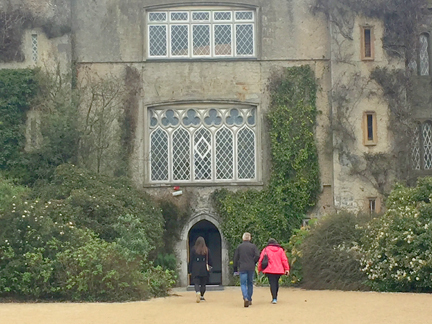 Malahide
MalahideWhen I think of each location, something tactile comes to mind. Something unforgettable. At Drogheda, for example, it was the cold mist that obscured the distance, and what seemed to me a light humor overlaying a lingering sorrow. At Tinahely you could take in beautiful vistas, but not without standing in deep ruts of mud. At Skibbereen there is something bittersweet in its essence, and yet comforting in the way its buildings are rooted against the banks of the River Ilen. Each of these places experienced terrible histories, and survived.
But nothing compares to the emotion that rises, standing at the edge of the Cliffs of Moher in County Clare. Here, in the rain, the wind, the crashing sea and fearsome beauty of the shear drop to the rocks, the lungs and heart swell. It’s a place of power, renewal, and pride. The cliffs themselves are raw elegance, the jutting chins of defiance and determination. It is eternal.
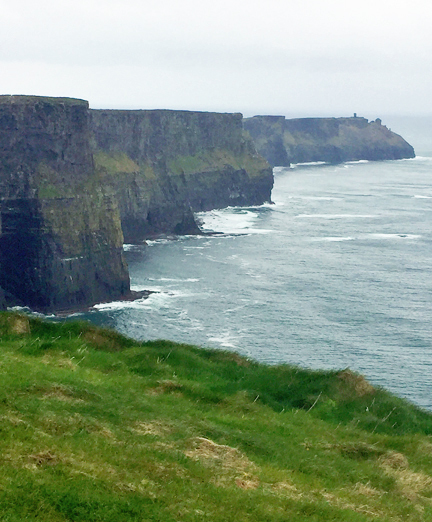 Cliffs of Moher in County Clare.
Cliffs of Moher in County Clare.I can learn much from the books and journals and other sources that fill my office and file folders. But they will never stir this kind of passion that drives my soul. Each time I think of it I still take in my breath.
Another benefit of my travels has been finding books I’ve found nowhere else, that provide the kinds of local and historical details a writer loves. In years past, I’ve found wonderful books in the gift shops at castles and museums. Unfortunately, that seems to be changing, perhaps because those books don’t sell as well as the t-shirts, hats and trinkets. During my visit to Dublin Castle, there was only one picture book offered with a brief history of the castle. And at Trinity College library gift shop, I was astonished and saddened to find its bookshelf completely empty.
Taking up the slack are some online library services like Google Books. Though that grand digitization project was stalled, I have found a number of volumes there and elsewhere that answer questions few people in the trinket shops will be asking.
And even better, I came home with books, documents and verbal information received from the historian, archaeologist, and other people I met during the trip.
Travels, like this last one, can be whirlwind experiences, trying to take in as much as possible within only a week to ten days at a time—what my schedule allows. In such cases I find, when I review my notes and pictures, and take time to focus my thoughts on a place, it does come back to me and I can see and feel the experience again. The result satisfies that double-edge sword, bringing both joy and confidence to writing.
The Prince of Glencurragh
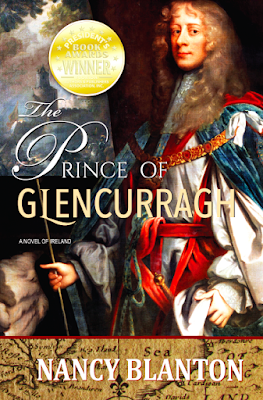 As the son of a great Irish warrior, Faolán Burke should have inherited vast lands and a beautiful castle, Glencurragh. But tensions grow in 1634 Ireland, as English plantation systems consume traditional clan properties, Irish families are made homeless, and Irish sons lose their inheritance. Encountering the beautiful heiress, Vivienne FitzGerald, Faolán believes if they were to marry, together they could restore his stolen heritage and build a prosperous life. But, because the Earl of Cork protects her, abduction seems to be his only option.
As the son of a great Irish warrior, Faolán Burke should have inherited vast lands and a beautiful castle, Glencurragh. But tensions grow in 1634 Ireland, as English plantation systems consume traditional clan properties, Irish families are made homeless, and Irish sons lose their inheritance. Encountering the beautiful heiress, Vivienne FitzGerald, Faolán believes if they were to marry, together they could restore his stolen heritage and build a prosperous life. But, because the Earl of Cork protects her, abduction seems to be his only option.Best friend Aengus O’Daly narrates as he and the brothers Thomas and Sean Barry help Faolán to complete the deed, and hasten to the Earl of Barrymore, who has promised to negotiate the marriage settlement. But Vivienne clearly has a mind of her own, and the adventure that began as a lark takes a dark turn when one man is injured, another is killed, and their plans for Barrymore’s support go awry.
Faolán now finds himself in the crossfire between the four most powerful men in Ireland—the earls of Clanricarde, Cork, Ormonde, and the aggressive new Lord Deputy of Ireland, Thomas Wentworth—men who use people like game pieces to be moved about for their own benefit. And other forces threaten their plans, and even their lives. With the course of events now beyond their control, will Faolán and Vivienne ever realize the dream of Glencurragh?
Amazon US Amazon UK
Sharavogue: A Novel of Ireland and Montserrat
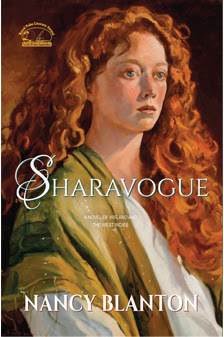 In December of 1649, England's Oliver Cromwell leads his brutal army across Ireland to crush a violent rebellion. Elvy Burke, daughter of a warrior, wants one thing--to live her destiny as a leader and defender of her country. As the cavalry approaches her village, Elvy knows she will not give up easily. Fleeing his soldiers, she aligns with a Scottish outlaw whose schemes send them headlong into a tumultuous journey across the sea to the West Indies. Elvy now wants only to survive, escape, find her sworn enemy Cromwell and kill him. Sharavogue is first place winner of the Royal Palm Literary Award for historical fiction.
In December of 1649, England's Oliver Cromwell leads his brutal army across Ireland to crush a violent rebellion. Elvy Burke, daughter of a warrior, wants one thing--to live her destiny as a leader and defender of her country. As the cavalry approaches her village, Elvy knows she will not give up easily. Fleeing his soldiers, she aligns with a Scottish outlaw whose schemes send them headlong into a tumultuous journey across the sea to the West Indies. Elvy now wants only to survive, escape, find her sworn enemy Cromwell and kill him. Sharavogue is first place winner of the Royal Palm Literary Award for historical fiction.Amazon US Amazon UK
Nancy Blanton
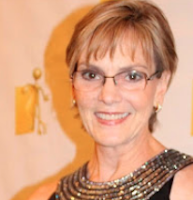 Nancy Blanton is the author of award-winning novels based primarily in Irish history. The Prince of Glencurragh (July 2016), her second novel, is set in 1634 prior to the great rebellion of 1641.The book has won Florida's Royal Palm Literary Award for historical fiction and was named first runner up for Book of the Year. It has also medaled in the Feathered Quill Book Awards and is a top finalist in Amelia Island Book Festival's Book Island Literary Awards and M.M. Bennetts Prize for Historical Fiction.
Nancy Blanton is the author of award-winning novels based primarily in Irish history. The Prince of Glencurragh (July 2016), her second novel, is set in 1634 prior to the great rebellion of 1641.The book has won Florida's Royal Palm Literary Award for historical fiction and was named first runner up for Book of the Year. It has also medaled in the Feathered Quill Book Awards and is a top finalist in Amelia Island Book Festival's Book Island Literary Awards and M.M. Bennetts Prize for Historical Fiction.Her first novel, Sharavogue, also set in 17th century Ireland, is the 2014 winner of Florida’s Royal Palm Literary Award.
Her third book, The Earl in Black Armor, set in the time of Thomas Wentworth, is scheduled for publication in late 2018.

Coming soon...
Visit Nancy at nancyblanton.com
Published on November 09, 2018 23:00
No comments have been added yet.
The Coffee Pot Book Club
The Coffee Pot Book Club (formally Myths, Legends, Books, and Coffee Pots) was founded in 2015. Our goal was to create a platform that would help Historical Fiction, Historical Romance and Historical
The Coffee Pot Book Club (formally Myths, Legends, Books, and Coffee Pots) was founded in 2015. Our goal was to create a platform that would help Historical Fiction, Historical Romance and Historical Fantasy authors promote their books and find that sometimes elusive audience. The Coffee Pot Book Club soon became the place for readers to meet new authors (both traditionally published and independently) and discover their fabulous books.
...more
...more
- Mary Anne Yarde's profile
- 159 followers



